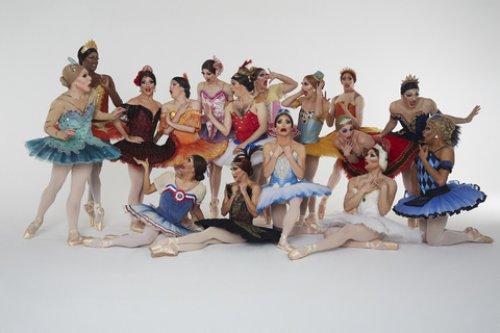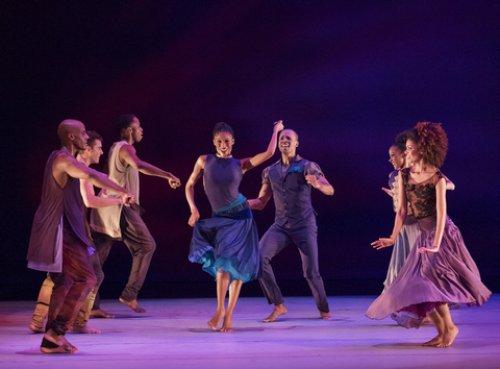Fall for Dance 2017
An opportunity to see many kinds of dance at a low ticket price at New York's famed City Center.

Dorrance Dance in a scene from “Myelination” (Photo credit: Stephanie Berger)
[avatar user=”Joel Benjamin” size=”96″ align=”left” ] Joel Benjamin, Critic[/avatar] New York City Center’s annual celebration of Terpsichore, Fall for Dance, is currently in mid-celebration. I caught Programs A and C which included eight companies, all distinguished, all interesting in different ways and all received well by the FFD audience which is probably the most enthusiastic in the world.
Each program had one decisive standout. In Program A, it was Fall for Dance Commission, Dorrance Dance’s “Myelination,” a tap fantasia with dramatic and humorous overtones danced to scintillating jazz music by Prawn Til Dante (Donovan Dorrance and Gregory Richardson), played live by a band of six brilliant musicians, including the two composers.
Michelle Dorrance, this troupe’s director, has become a force in tap dance because she understands both its legacy and its future. She played Pied Piper to a large troupe of very talented dancers who were all given opportunities to shine and create moods that varied from sexy to flirtatious to hilarious and sad. With additional choreographic contributions by Ephrat “Bounce” Asherie and Matthew “Megawatt” West—fine soloists—“Myelination” ebbed and flowed as soloists floated out of groupings of the twelve dancers to express themselves in brilliant bits that combined tap with modern dance, jazz, break dancing and even a touch of ballet.
Kathy Kaufmann’s lighting aligned with the mood of the changing music and steps while always letting the audience see the musicians who were a show in themselves.

Les Ballet Trockadero de Monte Carlo
The highlight of Program C was Les Ballets Trockadero de Monte Carlo’s hilariously stylish staging of “Paquita,” brought to life by ballerina Elena Kunikova with an attention to detail that would make major ballet companies jealous. This drag troupe brought the audience to its feet with its combination of an obvious love of ballet and outrageous interpretations.
From the kitschy set by Mike Gonzales (who also designed the very detailed and beautiful classical tutus) to the jokes that lovingly mocked classical ballet’s multitude of traditions. Whether it was a corps de ballet member who wore eyeglasses or a danseur noble who flirted with the girls of the chorus, this production—danced much better than the last time I saw it a few months ago—used humor that organically effervesced from the actual ballet. What could be more fun than a dancer facing the wrong way? Or, one slip up causing a cascade of falls? Or, a danseur, Boris Mudko (aka Giovanni Ravelo) who believes his simplified solo—just one step repeated about thirty times—is the best thing since sliced bread? Or, this same danseur needing help from two muscular corps members to lift his prima ballerina (Yakaterina Verbosovich, aka Chase Johnsey)?
Each soloist flirted deliciously with the audience while still acquitting themselves technically. (American Ballet Theatre’s artistic director, Kevin McKenzie was sitting across the aisle from me enjoying himself so much that I tempted to ask him which of the Trock dancers he was thinking of stealing away for ABT!)
Program A began with the Miami City Ballet’s interpretation of Christopher Wheeldon’s early work “Polyphonia,” choreographed to short pieces by György Ligeti played by Francisco Rennó. This nifty ballet troupe, directed by Lourdes Lopez, danced the work well, but Wheeldon’s witty references to Balanchine and the use of the now-ubiquitous Ligeti score, has dimmed the work’s sheen since the 2001 work announced Wheeldon’s special talent for creating ballets.

Vincent Sekwati Koko Mantose in a scene from “Gula” (Photo credit: Stephanie Berger)
“Gula,” an African tale choreographed by Vincent Sekwati Koko Mantsoe, was an engrossing solo performed by Mantsoe who used a colorful combination of self-produced bird sounds and music by Gabrielle Roth and the Mirrors to show a man metamorphing from human to bird and back again. As he looped about the stage in long strides, his graceful upper body language and head gestures made it clear what was going on. Carrie Cox’s lighting, bouncing off a stage haze, was instrumental in telling the tale.
Modern dance was represented by the late Trisha Brown’s “You can see us,” scored in a rather a pointillistic, spare style and costumed by avant-garde giant Robert Rauschenberg. Cecily Campbell and Jamie Scott, members of the Trisha Brown Dance Company, dressed in Rauschenberg’s loose, pale outfits, performed a mirror dance, a variation on an earlier Brown work in which she experimented with dancing entirely with her back to the audience. In “You can see us” she turned the older work into a mirror dance in which the two copied each other, one facing front, the other back, performing Brown’s soft peddling steps, leg raises and quiet arm gestures, undermining the original work’s intent, but creating a quiet oasis in Program A.

Sanjukta Sinha in a scene from “Kin-Incede” (Photo credit: Vipul Sangui)
Program C opened with a modern take on classical Indian dance. The Sanjukta Sinha, Icecraft Dance Company (odd name!) presented “Kin-Incede,” a solo performed by the charismatic Ms. Sinha, dressed in a long, loose red dress with matching leggings underneath. The Indian music, composed by Bernhard Schimpelsberger (another odd name for a composer of East Indian music!) was played by four on stage musicians who were intimately involved with Ms. Sinha’s interpretation of an array of deep emotions such as love and longing.
In “Kin-Incede” Ms. Sinha fell to her knees several times in anticlimactic endings only to then proceed anew after a short pause. However, each section was beautifully danced with her extraordinary footwork, elegant spins about the stage and eloquent use of her hands and face.
Fabiana Piccioli’s lighting was too arbitrary and noticeable in its sudden changes.
American Ballet Theatre was represented by “Souvenir d’un lieu cher” by their in-house choreographer, Alexei Ratmansky, a work to Tchaikovsky. It is very similar to Antony Tudor’s “Lilac Garden.” Ratmansky, like Tudor, sets two couples—in this case Stella Abrera, Thomas Forster, Sarah Lane and Taylor Maloney—adrift in the lovely Tchaikovsky score where they reveal through gestures, glances and imaginative partnering their longings, frustrations and desperation. It was beautifully danced.

Alvin Ailey American Dance Theater in a scene from Ronald K. Brown’s “Open Door” (Photo credit: Paul Kolnik)
Ronald K. Brown’s sexy “Open Door” was the contribution of the Alvin Ailey American Dance Theater. Performed by ten intense dancers, “Open Door” was an extraordinary exhibition of rhythmically complex body isolations performed to Latin-inflected music by Luis Demetrio, Arturo O’Farrill and Tito Puente. Brown staged this work as a ritual that brought a community together, soloist by soloist, until the entire cast celebrated in an undulating line of sensuality that filled the City Center Stage. Brilliantly lit by Al Crawford and colorfully costumed by Keiko Voltaire, this was the Alvin Ailey troupe at its best and most exciting.
New York City Center’s Fall for Dance provides a unique opportunity to see a variety of dance forms in a single performance. It draws a wide-ranging audience from the seasoned balletomane to the casually interested and has become a firmly entrenched artistic institution.
Fall for Dance 2017 (October 2-14, 2017)
New York City Center, 131 West 55th Street, in Manhattan
For tickets, call 212-581-1212 or visit http://www.nycitycenter.org
Running times: Program A – 90 minutes including one intermission;
Program C – two hours including one intermission






Leave a comment